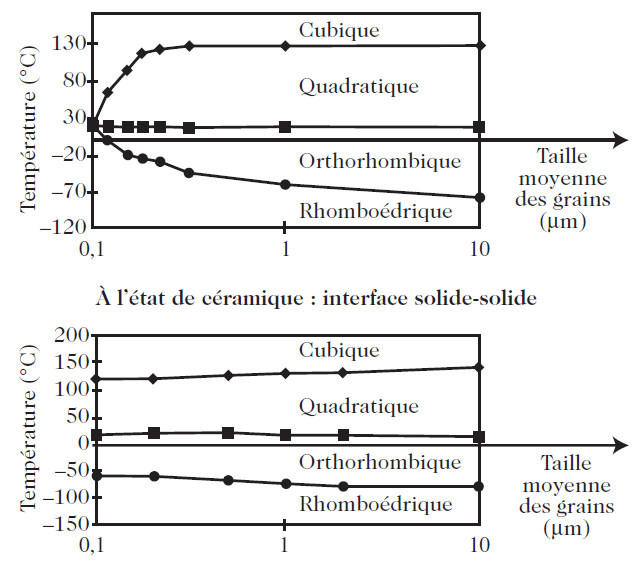


 علم الكيمياء
علم الكيمياء 
 الكيمياء التحليلية
الكيمياء التحليلية 
 الكيمياء الحياتية
الكيمياء الحياتية 
 الكيمياء العضوية
الكيمياء العضوية 
 الكيمياء الفيزيائية
الكيمياء الفيزيائية
 الكيمياء اللاعضوية
الكيمياء اللاعضوية 
 مواضيع اخرى في الكيمياء
مواضيع اخرى في الكيمياء
 الكيمياء الصناعية
الكيمياء الصناعية | A Simple Example about Influence of the Surface or Interface on Nanocrystals |
|
|
|
Read More
Date: 2-12-2015
Date: 3-2-2016
Date: 28-2-2016
|
A Simple Example about Influence of the Surface or Interface on Nanocrystals
Let us return to BaTiO3. Quite recently, the role of the outer interface on transition temperatures in barium titanate has been investigated (Fig. 1).

Fig. 1. Transition temperatures for BaTiO3 as a function of grain size . Upper: In the powdered state (solid–gas interface). Lower : In the ceramic state (solid–solid interface)
In the first case, BaTiO3 is in powdered form and hence has an outer surface which is a solid–gas interface. In the second case, the material is in the form of a microstructure composed of agglomerated grains, i.e., a ceramic with varying degrees of density. In this case, there is a solid–solid interface between grains.
The two phase diagrams are clearly different. Thus, for a given grain size and temperature, different phases can be stabilised depending on the state of the interface.
Still in the second case, for a solid–solid interface, a very slight variation is observed in the transition temperatures as a function of grain size. Nanograins in a bulk solid material would therefore appear to behave like large grains.
The surface effect would thus seem to disappear if the nanocrystal is bounded by an outer interface with nanocrystals that are identical to it.



|
|
|
|
التوتر والسرطان.. علماء يحذرون من "صلة خطيرة"
|
|
|
|
|
|
|
مرآة السيارة: مدى دقة عكسها للصورة الصحيحة
|
|
|
|
|
|
|
نحو شراكة وطنية متكاملة.. الأمين العام للعتبة الحسينية يبحث مع وكيل وزارة الخارجية آفاق التعاون المؤسسي
|
|
|